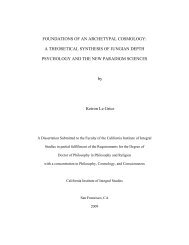The Psychoanalysis of Fire - HEIDI GUSTAFSON
The Psychoanalysis of Fire - HEIDI GUSTAFSON
The Psychoanalysis of Fire - HEIDI GUSTAFSON
Create successful ePaper yourself
Turn your PDF publications into a flip-book with our unique Google optimized e-Paper software.
PSYChOillh1lysis <strong>of</strong> <strong>Fire</strong><br />
the naive ideas thac have been developed about it, fire affords<br />
examples <strong>of</strong> the substa7ltialistic obstacle and <strong>of</strong> the animistic<br />
obstacle which both impede scienrific [hougIH.<br />
Vi e shall nrst put forward cases in which [he substantia list<br />
assenions are presented 'withom the slightest pro<strong>of</strong>. <strong>The</strong> Reverend<br />
Father L. Castel does not question the 1'ealism <strong>of</strong> firc: 3 "<strong>The</strong><br />
dark colors used in painting are for the most part the products <strong>of</strong><br />
nre, and fire always leaves something corrosive and burning in<br />
the bodies which have received its hot imprint. Some people<br />
claim that these are the igneous parts, composed <strong>of</strong> a true fire,<br />
[hat remain in different kinds <strong>of</strong> lime, in ashes, in coals and in<br />
various types <strong>of</strong> smoke." Nothing justifies this substantial persistence<br />
<strong>of</strong> fire in coloring matter, bur the suhstantialist thought<br />
can be seen at work: that which has received fire must remain<br />
burning, and hence corrosive.<br />
Sometimes the substanrialist assertion is presented in untroubled<br />
purity, quite free from any attempt at pro<strong>of</strong> and even<br />
from any illustrative image. Thus Ducarla writes: 4 "<strong>The</strong> igneous<br />
molecules ... heat because they are; they are because they<br />
have been ... This action never stops going on except for lack<br />
<strong>of</strong> an object." <strong>The</strong> tautological nature <strong>of</strong> the substantial attribution<br />
is here particularly clear. <strong>The</strong> joke <strong>of</strong> Moliere about the<br />
dormirive virtues <strong>of</strong> opium which makes you sleep did not<br />
prevent an important, lace eighteenth-century author from saying<br />
that the calorific virtue <strong>of</strong> heat has the property <strong>of</strong> heating.<br />
For many minds, fire has such value that nothing limits its<br />
power. Boerhaave claims to make no assumption concerning fire,<br />
but he begins by stating without the least hesitation that "the<br />
elements <strong>of</strong> <strong>Fire</strong> are met evetywhere; they are found in gold,<br />
which is the most solid <strong>of</strong> all known bornes, and in the vacuum <strong>of</strong><br />
Torricelli." 5 For a chemist as for a philosopher, for an educated<br />
man as for a dreamer, fire is so easily endowed with a substance<br />
that it can be attached equally well to the vacuum as to the<br />
plenum. Doubtless modern physics will recognize that the<br />
vacuum is traversed by the thousand radiations <strong>of</strong> radiant heat,<br />
but it will not claim that these radiations are a quality <strong>of</strong> empty<br />
space. If a light is produced in the vacuum <strong>of</strong> a barometer that<br />
62<br />
CI.,m:is,ry <strong>of</strong> <strong>Fire</strong><br />
is being shaken, the sciemific mind will nor conclude from this<br />
that rhe vacuum <strong>of</strong> Torricelli cont.?ined intent fire.<br />
<strong>The</strong> substanrializacion <strong>of</strong> fire e:J.sily reconciles its conrradictory<br />
characteristics: fire can be quick and Llpid in its dispersed<br />
forms; deep and lasting in its concentrated forms. Ir will only be<br />
necessary to invoke substcmtial concentration in order to account<br />
for irs most varied aspects. For Carra, an author <strong>of</strong>ten quoted at<br />
the end <strong>of</strong> the eighteenth century: B<br />
In straw and pape(, the phlogiston component is 'lery rare, whereas<br />
it is abundant in coal. <strong>The</strong> first tWO su bstances nevertheless flame<br />
up at the first approach <strong>of</strong> fire, whereas the latter takes a long time<br />
to burn, One can explain this difference in effect only by recognizing<br />
chat the phlogiston component: <strong>of</strong> straw and <strong>of</strong> paper, although rarer<br />
than that <strong>of</strong> coal, is iri them less concentrated., more disseminated,<br />
and consequently more liable to a qu.ick development.<br />
Thus an insignificant experiment like that <strong>of</strong> a piece <strong>of</strong> paper<br />
being quickly set on fire is explained in irs intensity by the degree<br />
<strong>of</strong> substantial concentration <strong>of</strong> the phlogiston. vVe must stress<br />
here this need to explain the details <strong>of</strong> a first experience. This<br />
need for minute explanation is quite symptomatic in non-scientific<br />
minds, which claim to neglect nothing and to take into<br />
account all the aspec(s <strong>of</strong> the concrete experience. <strong>The</strong> quickness<br />
<strong>of</strong> a fire thus oHers false problems: this quickness made such a<br />
great impression on our imagination in our childhood! <strong>The</strong> straw<br />
fire remains, for the unconscious, a characteristic fire.<br />
Similarly in the work <strong>of</strong> Marat, a presciencific mind <strong>of</strong> little<br />
intellectual power, the connection <strong>of</strong> the first experience wim<br />
the substancialist inruition is equally direct. In a pamphlet which<br />
is merely a precis <strong>of</strong> his Physical Research into <strong>Fire</strong> (Recherches<br />
physiques sur le Feu), he expresses himself as follows: 7<br />
Why does the igneous fluid attach itself only to inflammable substances?-by<br />
virtue <strong>of</strong> a particular affinicy becween its globules and<br />
the phlogiston with which these substances are saturated. This<br />
attraction is quite obvious. When, by blowing air through a blowpipe,<br />
we attempc to separate from the combustible material the flame<br />
63



